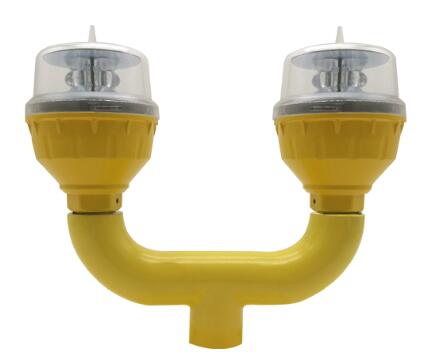
In the field of aviation, safety is the highest priority, and effective visibility plays a critical role in ensuring safe flights. Among the various devices designed to improve visibility, the double obstruction light stands out as a crucial component for aviation safety. These lights are commonly used to mark tall structures such as communication towers, wind turbines, and other elevated objects that may pose a hazard to aircraft, especially in low visibility conditions or at night. The double obstruction light is specifically designed to offer both daytime and nighttime warnings to pilots, providing a level of safety that is indispensable for modern aviation.
Understanding the Double Obstruction Light
A double obstruction light refers to a lighting system that incorporates two distinct light sources, each designed to provide an enhanced signal to pilots. This system typically combines a high-intensity strobe light for nighttime or low-visibility conditions and a steady-burning light for daytime or clear conditions. The combination of both light types ensures that the obstacle is clearly visible in a range of conditions, increasing the likelihood of avoiding accidents.
The double obstruction light system is particularly effective in marking structures that are located in remote areas or where other warning systems may be impractical. By offering two different types of illumination, these lights are able to fulfill multiple safety needs. The strobe light, usually flashing in high-intensity bursts, is designed to catch the attention of pilots in the dark sky or in foggy, overcast conditions. In contrast, the steady-burning light is a continuous beam that is visible even during the day, providing an ongoing warning to pilots who are approaching during daylight hours.

Features and Benefits
One of the key features of the double obstruction light is its dual-functionality, which allows it to address both day and night needs. For nighttime visibility, the strobe light is especially important, as it can be seen from long distances and in challenging weather conditions. Its high intensity and flashing nature create a stark contrast against the dark sky, ensuring it is noticed even by pilots flying at high altitudes.
For daytime conditions, the steady-burning light serves as a constant and reliable indicator of an obstacle. This is important because, during daylight, strobe lights can be difficult to see, especially in clear skies where the flashing effect is less noticeable. The steady-burning light, however, provides a continuous beacon that can be seen from miles away, making it an essential component for daytime safety.
Another significant advantage of the double obstruction light is its energy efficiency and durability. These lights are often designed to be weather-resistant and capable of withstanding extreme environmental conditions. Whether in a harsh desert environment, on a high mountain, or in a humid coastal area, the double obstruction light is built to endure and continue providing safety for years.
The integration of both types of lighting in a single system also simplifies installation and maintenance. Instead of installing multiple distinct lights for day and night, the double obstruction light combines both functions into one unit, reducing the complexity of setup and upkeep. This results in lower costs for infrastructure and maintenance while still maintaining the highest standards of visibility and safety.
|
double obstruction light |
double obstruction lights |
Applications of Double Obstruction Lights
The double obstruction light is commonly used in various applications across industries, especially in aviation and infrastructure sectors. The most notable use is in marking tall structures like telecommunications towers, radio masts, and tall buildings that are at risk of being struck by aircraft. These structures, due to their height, present a significant hazard to low-flying aircraft, particularly in poor visibility conditions. Without proper lighting, these obstacles could be invisible to pilots, leading to potentially catastrophic accidents.
Wind farms, which often consist of large wind turbines spread across vast areas, are another common site where double obstruction lights are deployed. These turbines, due to their height and rotating blades, can pose serious risks to flying aircraft, especially at night or in foggy weather. The use of both strobe and steady-burning lights ensures that these structures are visible to pilots, significantly reducing the risk of collisions.
In addition to aviation safety, double obstruction lights are also used in marine navigation, marking hazards like oil rigs or navigation buoys. Ships navigating through open waters rely on visible markers to avoid collisions, and the dual-light system provides a versatile and effective solution for ensuring that these obstacles are clearly visible from a distance.
Regulatory Standards and Compliance
The use of double obstruction lights is governed by various international standards and regulations, particularly those set by aviation authorities such as the Federal Aviation Administration (FAA) and the International Civil Aviation Organization (ICAO). These regulations stipulate the necessary specifications for the lights' brightness, range, and mounting requirements, ensuring that all tall structures are properly marked and visible to pilots.
Compliance with these standards is essential for ensuring that the lights are effective and reliable. Failure to meet these regulations can result in fines, increased risk of accidents, and a negative impact on public safety. Therefore, when choosing and installing double obstruction lights, it is important to ensure that the system adheres to the appropriate guidelines set forth by relevant regulatory bodies.
The double obstruction light plays a vital role in aviation and other industries that deal with tall structures. By providing both day and night visibility, it offers a level of safety that is indispensable for modern air travel. With its high-intensity strobe light for nighttime use and steady-burning light for daytime visibility, this dual-function lighting system ensures that tall structures are clearly marked and easily visible, reducing the risk of collisions and improving overall safety. The double obstruction light is a reliable, energy-efficient solution that continues to save lives and prevent accidents, making it an essential tool in the ongoing effort to improve safety in aviation and beyond.